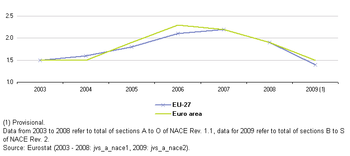Archive:Job vacancy trends
- Data from October 2010, most recent data: Further Eurostat information, Main tables and Database.
This article gives an overview of recent job vacancy statistics in the European Union (EU), notably the job vacancy rate. EU policies in the area of job vacancies aim to improve the functioning of the labour market by trying to more closely match supply and demand. In order to enable job seekers to consult all vacancies publicised in each of the Member State's employment services, the European jobs and mobility portal (EURES) was set up.
Recent and regularly job vacancy statistics are analysed in another article
Main statistical findings
There was an upward development in the job vacancy rate in the EU-27, with the rate rising during four consecutive years through to a relative peak of 2.2 % in 2007. The EU-27 job vacancy rate then fell to an historic low of 1.4 % in 2009; the time series for this indicator is available from 2003 onwards.
Among the Member States for which data are available, the job vacancy rate in 2009 was highest in Germany (2.5 %), Malta (1.8 %) and the United Kingdom (1.7 %); the rate was lowest in France and Latvia (both 0.3 %).
Data sources and availability
Data on job vacancies and occupied posts may be presented broken down by economic activity, occupation, size of enterprise and region. The national statistical authorities responsible for compiling job vacancy statistics send these statistics to Eurostat. Their data are used to compile the job vacancy rate for the EU and the euro area.
Some of the data provided by the Member States fails to match common criteria and there may be differences in the coverage of the data between countries; as a result, there are currently no EU-27 totals for the actual numbers of job vacancies or occupied posts. The EU-27 and euro area job vacancy rates are calculated on the basis of the information that is available; no estimates are made for missing or incomplete data. It is therefore not possible, at present, to present EU-27 or euro area job vacancy rates broken down by economic activity, occupation or size of enterprise.
Context
The job vacancy rate, in part, reflects the unmet demand for labour, as well as potential mismatches between the skills and availability of those who are unemployed and those sought by employers. Job vacancy statistics are used by the European Commission and the European Central Bank (ECB) to analyse and monitor the evolution of the labour market at national and European level. These statistics are also a key indicator used for an assessment of the business cycle and for a structural analysis of the economy.
Policy developments in this area have mainly focused on trying to improve the labour market by more closely matching supply and demand, through:
- modernising and strengthening labour market institutions, notably employment services;
- removing obstacles to worker mobility across Europe;
- better anticipating skill needs, labour market shortages and bottlenecks;
- managing economic migration;
- improving the adaptability of workers and enterprises so that there is a greater capacity to anticipate, trigger and absorb economic and social change.
The European jobs and mobility portal (EURES) was set-up with the aim of providing job seekers in the EU with the opportunity to consult all job vacancies publicised in each of the Member State's employment services. The website provides access to a range of job vacancies from 31 European countries (the 27 EU Member States, as well as Iceland, Liechtenstein, Norway and Switzerland). In autumn 2010, there were around one million job vacancies advertised by over 22 000 registered employers on the website, while more than 500 000 people had posted their CVs on the website.
European job days are another EU initiative in this domain and 2010 was the fourth edition of this programme of activities: during September and October 2010, a wide range of events (around 500) took place all over Europe with the aim of raising awareness about the opportunities and practicalities of living and working in another European country. The events typically include job fairs, seminars, lectures, workshops and cultural events, all aimed at improving labour mobility.
Further Eurostat information
Publications
Main tables
- Job vacancies
- Main tables
- Job vacancies (t_jvs)
- Quarterly job vacancies and job vacancy rates, total NACE_Rev2 (sections B to S) (tps00172)
- Job vacancies (t_jvs)
- Main tables
Database
Methodology/Metadata
- Annual job vacancy statistics (ESMS metadata file - jvs_a_esms)
Source data for tables, figures and maps on this page (MS Excel)
External links
- EURES, the European jobs and mobility portal
- OECD - StatExtracts - Registered Unemployed and Job Vacancies (MEI): Job Vacancies

